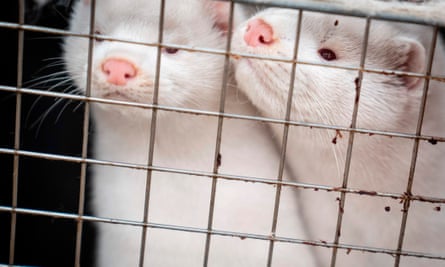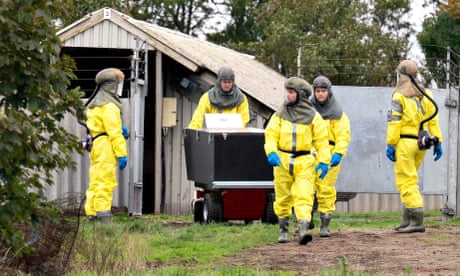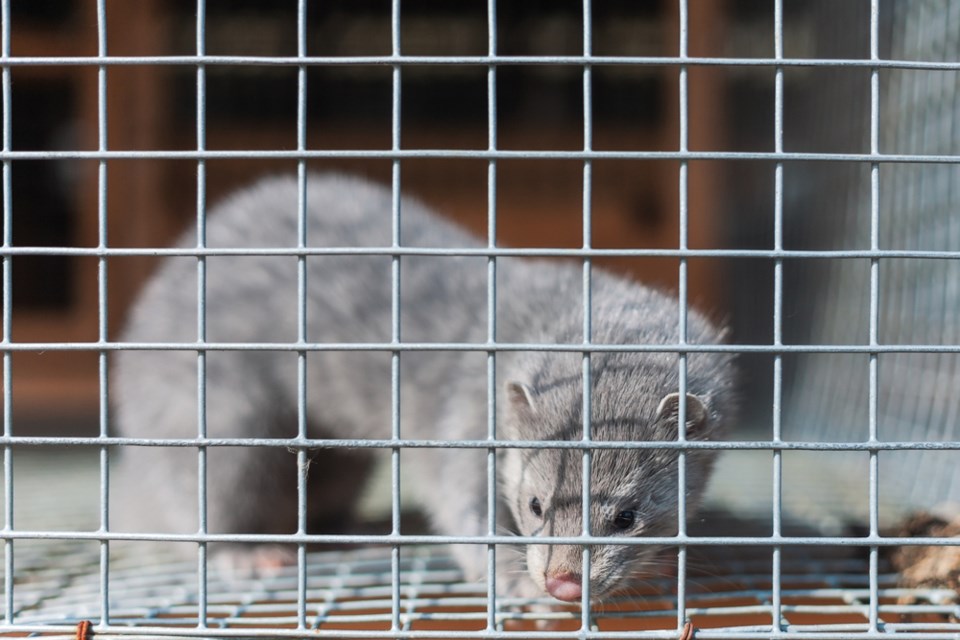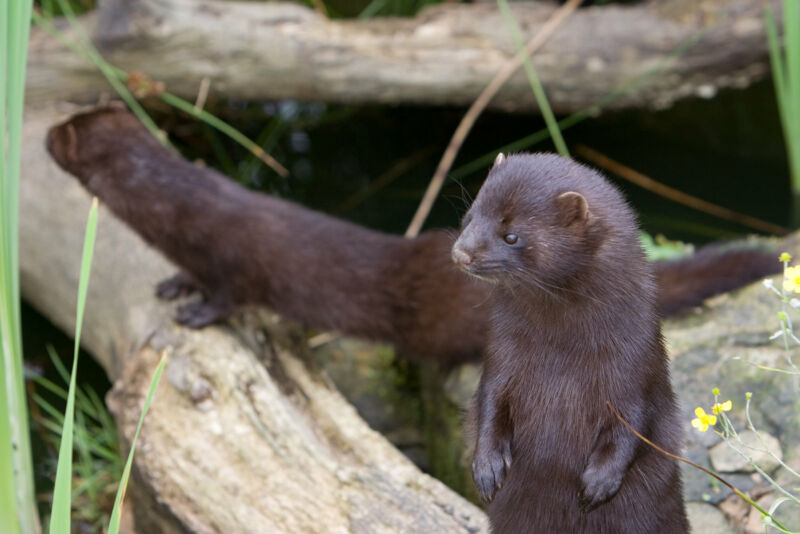Amid ongoing debate over the threat posed by COVID-19 outbreaks on mink farms, state authorities in Utah allegedly failed to disclose the COVID-19 death of a mink farm worker linked to a coronavirus outbreak at a mink farm in the state.

The Utah Department of Agriculture and Food (UDAF) has also allegedly not been transparent about COVID-19 transmission in the wild and downplayed the threat mink farm COVID-19 outbreaks pose to humans, animal rights groups claim.
Scientists have previously warned the diseased mink could create a new uncontrollable store and vector for the transmission of coronavirus to humans and potentially pose a risk to future COVID-19 vaccines.
The mink farm outbreaks in Utah, which marked the country's first confirmed cases of COVID-19 infection in mink, were announced in statements released by the UDAF as well as the U.S. Department of Agriculture Animal and Plant Health Inspection Service (USDA APHIS) on August 17, 2020.
According to an email shared with Newsweek, which was among several documents obtained by an open records request made by the Utah Animal Rights Coalition (UARC) who shared the files with Direct Action Everywhere (DxE), an animal rights network based in the San Francisco Bay Area, "one farm manager has died from SARS-CoV-2 infection" following the coronavirus outbreaks at two mink farms in Utah back in August.
Neither of the August statements released by the UDAF and USDA APHIS mentioned the death of the mink farm manager noted in the aforementioned email, which was sent on August 10, 2020, a week before the statements were released by the UDAF and USDA.
Speaking to Newsweek, Wayne Hsiung, an attorney and investigator for DxE, which he co-founded, said: "The document [the email] was obtained through the state of Washington because the lab that did the testing for Utah mink farms was a public university in Washington. The state of Utah itself has refused to make these disclosures, citing the risk of break-ins by animal rights activists (including specifically DxE), and has never disclosed the site of any outbreaks, much less that an employee died."
In a blog post on the DxE website where the documents obtained by the open records request were published on Monday, Hsiung explained: "Given Utah's stonewalling, our partner groups submitted an open records act request to Washington State University [WSU], a public institution that is home to the Washington Animal Disease Diagnostic Library (WADDL), which carries out laboratory testing for the USDA and other agencies."
WSU released a set of documents including an email from Tom Baldwin, the director of the Utah Veterinary Diagnostic Laboratory (UVDL) at Utah State University who was the veterinarian investigating the COVID-19 outbreaks on the Utah mink farms at the time, according to Hsiung.
UVDL is "a cooperative effort by Utah State University (USU) and Utah Department of Agriculture and Food (UDAF)," according to its website.
Baldwin's email, which was sent to WADDL Executive Director Timothy Baszler and WADDL Director of Operations Kevin Snekvik, stated: "We have a number of mink farms in which adult mink are dying at concerning rates. Moreover, farm personnel are experiencing upper respiratory infections and one farm manager has died from SARS-CoV-2 infection."
As indicated in the email, Utah State Veterinarian Dr. Dean Taylor, who works for the UDAF, was copied in Baldwin's email.
Hsiung told Newsweek: "The state veterinarian of the UDAF is cc'd [copied] in the correspondence. Given his role in protecting public health, one can assume that he knew about this death—and has chosen to not disclose it in the various public communications."
What Utah state health department and CDC say
Asked whether the Utah Department of Health (UDOH) was aware of the death of the Utah mink farm manager, as well as several other questions relating to that death, a public information officer at the UDOH told Newsweek that the department has been involved in an "on-going, collaborative response and investigation" of the Utah mink farm COVID-19 outbreaks with the UDAF, CDC and USDA APHIS.
"This investigation resulted in the link of an individual who recently passed from COVID-19 and who happened to be employed at the mink farm. At the time the person became ill, community spread had been increasing rapidly in the surrounding area. No additional deaths associated with mink farms have been reported. Currently, there is no evidence of mink-to-human transmission in the United States.
"All human lab-confirmed COVID-19 cases are routinely reported to UDOH through normal channels. Confirmed COVID-19 cases are interviewed by a contact tracer and appropriate quarantines are recommended. When a person in Utah dies and has tested positive for COVID-19, the death is investigated and the cause is determined by the Office of the Medical Examiner. All of these normal reporting and response steps occurred in this particular instance.
"In August of 2020, the Utah Department of Agriculture and Food (UDAF) notified the UDOH of an unusually high rate of mink mortality on a Utah farm, along with the suspicion that the mink deaths might be related to SARS-CoV-2, the virus that causes COVID-19 in humans. Our federal partners were immediately notified and Utah invited CDC to deploy a team of One Health experts to assist with on farm investigations of SARS-CoV-2 in people, mink, and other animals on affected Utah mink farms. Our federal partners have continued to support UDAF and UDOH in this on-going investigation and response.
"In response to these outbreaks, UDOH conducted epidemiologic investigations on any mink farm with a confirmed case of SARS-CoV-2 among their herds. From these investigations, it is suspected that infected workers introduced SARS-CoV-2 to the farms, and the virus then spread between mink. All epidemiologic evidence and test results indicate human-to-mink transmission with a person with COVID-19 infection introducing the virus onto each farm," the UDOH public information officer said.
Asked the same questions about the farm employee death, as well as why the manager's death was not mentioned in the August 17 USDA statement, a spokesperson for USDA APHIS told Newsweek: "USDA's Animal and Plant Health Inspection Service (APHIS) has worked closely with the U.S. Centers for Disease Control and Prevention (CDC) and individual states, including Utah, throughout the COVID-19 outbreak to identify animals that should be tested, develop and recommend guidance for contact with animals, and to determine how to handle cases when they are confirmed in animals.
"APHIS' focus is on the health of animals in the United States, and our primary role is testing samples from animals and reporting confirmed cases to the World Organization for Animal Health (OIE). While we work closely with these partners on the overall response, it would be inappropriate for APHIS to maintain information about or comment on cases of COVID-19 in people. Your questions would be better directed to CDC [U.S. Centers for Disease Control and Prevention] or the Utah Department of Health," Cole added.
When the CDC was asked the same questions relating to the mink farm worker death, including whether the UDOH had reported that death in the state's COVID-19 death totals and shared any information about that death with the CDC, a spokesperson for the federal health body told Newsweek: "CDC defers to the Utah Department of Health to provide details on human COVID-19 cases linked with mink farms in their state. CDC has been collaborating with human and animal health officials in Utah and USDA regarding mink farms with SARS-CoV-2 since August 2020.
"Currently, there is no evidence of mink-to-human spread in the United States, however investigations are ongoing. Although, human cases have been identified in connection with all affected U.S. mink farms. It is suspected that infected workers introduced SARS-CoV-2 to mink on the farms, and the virus then began to spread among the mink and from mink to other animals like cats and dogs on the farm. Although for most people in the United States the risk of SARS-CoV-2 infection from animals is low, there is a higher risk for people working on mink farms," the spokesperson added.
Newsweek has contacted the UDAF, Taylor and Baldwin for comment.
Asked whether there was any further information available about the death of the Utah mink farm manager, including how the employee got infected, Hsiung told Newsweek: "No. And unless public health authorities were conducting prospective genomic surveillance among the mink and the workers, we will likely never be able to definitively answer this question.
Hsiung explained in Monday's DxE blog post: "We cannot be sure the farm manager at issue died from mink transmission, given that the state of Utah has not disclosed any genomic testing at this site or any other site.
"But it appears that those investigating the outbreak were alarmed at the rate of infection among workers on these farms, and this is supported by peer-reviewed research from the Netherlands showing that 68 percent of mink farm workers and their close contacts had evidence of SARS-CoV-2 infection, a far higher rate of infection than the general population," he told Newsweek.
COVID-19 transmission in the wild and threat to humans
Last April, the Netherlands became the first country in the world to report COVID-19 cases among mink.
In a statement on May 19, 2020, the Dutch government said: "New research findings in the ongoing investigation into COVID-19 at mink farms suggest there has been a transmission of new coronavirus from mink to human."
Hsiung noted in the Monday DxE blog post: "Even Fur Europe, an umbrella organization representing the European fur industry, circulated an alert acknowledging this new development, writing on May 26 to its members that the coronavirus is 'transmissible from human to mink, and likely transmissible back to humans again.'"
But the UDAF has allegedly downplayed the threat mink farm outbreaks pose to humans and claimed there was no COVID-19 transmission in the wild, according to the UARC and DxE.
Speaking to Newsweek, UARC Executive Director Jeremy Beckham, who made the aforementioned open records request to WSU, said: "Last month [December], I had a hearing in front of the Utah State Records Committee trying to pry more records from the Utah Department of Agriculture. During that hearing, they made the claim that no serious threat existed to workers or wild animals.
"In fact, at the time they made these claims to the committee, the agency already had evidence that wild mink had tested positive for SARS-CoV-2 and that farm workers had been infected, including a manager on a Utah County mink farm had died of COVID," Beckham said.
During the aforementioned hearing, held on December 8, 2020, the UDAF claimed "that wild transmission has not occurred (and repeated this at a hearing on Dec. 10) to justify the lack of disclosure about mink farm outbreaks," Hsiung told Newsweek.
"Their [UDAF] argument is: We don't need to tell anyone about this because we have it contained. Subsequently, on Dec. 11, it was revealed [in an international public health mailing list published on ProMED] that wild transmission [in wild mink] has occurred—and from testing done sometime from August through October. This shows the state's brief was false. Whether that falsehood was intentional, I cannot say.
"The state of Utah apparently knew about this positive test, yet continued to falsely state that no wild animal transmission had occurred," he said.
Hsiung noted in the Monday DxE blog post: "The release of COVID-19 to the wild was apparently important enough for USDA scientists to warn international disease experts about—making global headlines—but not important enough for Utah to tell its own citizens."
Hsiung also told Newsweek: "Utah also strangely argues in the same filing on Dec. 8 that, while the risk from mink farms is low, the risk from animal rights activists is very high—citing a number of articles about DxE.
"They're on a razor's edge here because, on the one hand, they want to say daily operations at mink farms are not dangerous enough for people to know about but, on the other, dangerous enough that we can't let animal rights advocates know where they are. This is a contradiction. Either mink farms are dangerous or they're not. They can't only be dangerous for animal rights activists, but not for employees or surrounding community members," Hsiung argued.
Speaking to Newsweek, the former chief veterinarian at the USDA's Food Safety and Inspection Service, noted: "If someone is looking for the exact locations of the affected mink farms to be identified, this is rather complicated as this would be under the State jurisdiction and not USDA/APHIS.
"That is because the regulations governing the actions APHIS can take as the federal branch of the government is limited by several factors, including whether or not the disease in causing illness in animals (as APHIS has no authority to address zoonotic infections), whether or not disease has spread outside the state boundaries and if the disease is located within the state borders, have they requested APHIS assistance; etc.
"With no mandatory animal ID laws, APHIS is quite often unable to confirm or share the exact farm location. APHIS has limited staff and relies on the local (state) 'certified' veterinarians to do their trace-backs. That also creates a problem when there is industry pressure on the state not to cooperate," Basu added.
COVID-19 outbreaks at Utah mink farms 'greatly worsened'
Beckham told Newsweek "the problem [COVID-19 outbreaks on Utah mink farms] has greatly worsened since August. We are up to at least 12 mink farms in Utah that have experienced COVID-19 outbreaks, as of early Dec 2020, which is the latest information I have. That's out of 36 farms total in the state. So one-third of Utah mink farms have been hit with COVID outbreaks.
"The latest statement that the Utah Department of Agriculture released is a press statement boasting that COVID-19 cases have been declining on Utah mink farms based on data collected in October and then December," Beckham added.
In a statement released on December 28, 2020, the UDAF stated: "UDOH and CDC began testing mink and other domestic animals on the farms, including dogs, cats and mice. Sampling also included farm workers and a small number of their household contacts. Initial testing showed positive results in mink, dogs, and feral cats on the farms.
"While the results and analysis are still underway for the third round of testing, there is encouraging evidence suggesting that the levels of virus are going down in the mink, cats and dogs living on the farm.
"Additional community sequencing is needed to fully understand the potential for transmission between people and different animal species in this area; however, at this time, based on extensive epidemiologic investigations, there has been no evidence to date of spread from mink to people in Utah," the statement said at the time.
However, Beckham told Newsweek: "This statement neglects to mention why it's impossible to draw any conclusions based on these data points: mink farms begin their 'pelting season' in November, where the overwhelming majority of their animals are killed and skinned, leaving only the breeding stock behind.
"Of course there are fewer COVID cases in mink—there are fewer mink. And the mink that do remain can be spaced in the sheds, making it more difficult for a respiratory virus to be transmitted. Breeding season starts in March and I fully expect to see these numbers rapidly climb again because the underlying problem has not been addressed," he added.
Related Articles
















